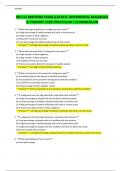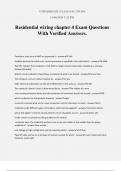ESTUDY
NR 511 MIDTERM EXAM (LATEST): DIFFERENTIAL DIAGNOSIS
& PRIMARY CARE PRACTICUM | CHAMBERLAIN
1. **What does high specificity in a diagnostic test mean?**
a) A high percentage of healthy people will show a normal result.
b) A high number of false-negatives.
c) All positive results are accurate.
d) A low percentage of healthy people show normal results.
- **Answer:** a) A high percentage of healthy people will show a normal result.
2. **What does low specificity in a diagnostic test mean?**
a) A high number of false-negatives.
b) A high number of false-positives.
c) All negative results are accurate.
d) The test accurately detects the disease in healthy people.
- **Answer:** b) A high number of false-positives.
3. **What is sensitivity in the context of a diagnostic test?**
a) The ability to detect the disease in healthy individuals.
b) The proportion of true positives among those with the condition.
c) The ability to avoid false-positive results.
d) The percentage of false-negative results.
- **Answer:** b) The proportion of true positives among those with the condition.
4. **If a diagnostic test has high specificity, what does that indicate?**
a) A high percentage of people with the condition will test positive.
b) A low percentage of healthy individuals will show a normal result.
c) A high percentage of healthy individuals will show a normal result.
d) The test has a high number of false-negatives.
- **Answer:** c) A high percentage of healthy individuals will show a normal result.
5. **If a diagnostic test has high sensitivity, what does that indicate?**
a) A low percentage of people with the condition will test positive.
b) A high percentage of healthy people will have an abnormal result.
c) A high percentage of people with the condition will have an abnormal result.
d) The test avoids false positives.
- **Answer:** c) A high percentage of people with the condition will have an abnormal result.
6. **What does Medicare Part A cover?**
a) Prescription drugs
,ESTUDY
b) Outpatient services and lab tests
c) Inpatient hospital stay, skilled nursing care, hospice, and home care
d) Vision exams and hearing aids
- **Answer:** c) Inpatient hospital stay, skilled nursing care, hospice, and home care
7. **What does Medicare Part B cover?**
a) Vision exams and hearing aids
b) Prescription drugs
c) Inpatient hospital stay and hospice
d) Outpatient services, provider visits, surgery, lab tests, medical equipment, and preventive exams
- **Answer:** d) Outpatient services, provider visits, surgery, lab tests, medical equipment, and
preventive exams
8. **What does Medicare Part C cover?**
a) Inpatient hospital stay and hospice
b) Prescription drugs
c) Vision exams, hearing exams, eyeglasses, and hearing aids
d) Outpatient services and lab tests
- **Answer:** c) Vision exams, hearing exams, eyeglasses, and hearing aids
9. **What does Medicare Part D cover?**
a) Vision exams and hearing aids
b) Prescription drugs
c) Inpatient hospital stay and hospice
d) Outpatient services, provider visits, and preventive exams
- **Answer:** b) Prescription drugs
10. **What are the symptoms of tinea versicolor?**
a) Itchy rash caused by mites
b) Flat to slightly raised brown papules and plaques with scaling, areas of lighter or darker skin, and
itching; usually on the trunk and shoulders
c) Ring-shaped lesions with scaly borders
d) Yellow discoloration of nails
- **Answer:** b) Flat to slightly raised brown papules and plaques with scaling, areas of lighter or
darker skin, and itching; usually on the trunk and shoulders
11. **What is balanitis?**
a) Inflammation of the glans penis due to bacterial infection
b) Inflammation of the glans penis caused by a fungal infection (candidiasis)
c) A painful, red bump under the skin due to infection of hair follicles
d) Scaly patches on the skin
- **Answer:** b) Inflammation of the glans penis caused by a fungal infection (candidiasis)
,ESTUDY
12. **What are the symptoms of tinea corporis?**
a) Scaly patches on exposed skin surfaces or on the trunk, with ring-shaped lesions having scaly
borders and central clearing
b) Painful red bump under the skin due to infection of hair follicles
c) Yellow discoloration of nails
d) Itchy rash caused by mites
- **Answer:** a) Scaly patches on exposed skin surfaces or on the trunk, with ring-shaped lesions
having scaly borders and central clearing
13. **What is tinea pedis commonly known as?**
a) Ringworm
b) Athlete’s foot
c) Jock itch
d) Nail fungus
- **Answer:** b) Athlete’s foot
14. **Where does tinea cruris (jock itch) typically occur?**
a) On the scalp
b) Between the toes
c) In the groin area
d) On the nails
- **Answer:** c) In the groin area
15. **What are the symptoms of tinea unguium (nail fungus)?**
a) Itchy, scaly rash on the trunk and arms
b) White or yellow nail discoloration, thickening of the nail, and separation from the nail bed
c) Ring-shaped lesions with scaly borders
d) Red, scaly patches on the face
- **Answer:** b) White or yellow nail discoloration, thickening of the nail, and separation from the
nail bed
16. **What is cellulitis?**
a) A bacterial infection of the hair follicle
b) A viral infection of the skin
c) A spreading infection of the epidermis and subcutaneous tissues, usually starting after a break in
the skin
d) A fungal infection causing itching
- **Answer:** c) A spreading infection of the epidermis and subcutaneous tissues, usually starting
after a break in the skin
17. **What is folliculitis?**
, ESTUDY
a) A fungal infection of the skin
b) A viral infection of the skin
c) A bacterial infection of the hair follicle causing small red bumps or papules
d) A chronic skin condition causing blushing or flushing
- **Answer:** c) A bacterial infection of the hair follicle causing small red bumps or papules
18. **What are the characteristics of impetigo?**
a) Chronic, non-contagious skin condition causing dry, itchy skin
b) A bacterial infection that is highly contagious, often with burning and itching, and may cause
swollen lymph nodes
c) A fungal infection causing scaly patches
d) A viral infection with blistering sores
- **Answer:** b) A bacterial infection that is highly contagious, often with burning and itching, and
may cause swollen lymph nodes
19. **What is an epidermal inclusion cyst?**
a) A fluid-filled sac under the skin
b) A painful red bump under the skin due to infection
c) A cyst that has been present at the same site for months to years, possibly with a cheesy white
discharge and strong odor when squeezed
d) A hard, sandpaper-like lesion on sun-exposed skin
- **Answer:** c) A cyst that has been present at the same site for months to years, possibly with a
cheesy white discharge and strong odor when squeezed
20. **What is cholinergic urticaria?**
a) Hives or wheals that occur after exposure to cold temperatures
b) Hives or wheals that are itchy and occur on the trunk and arms after exercise, anxiety, high body
temperature, or hot baths/showers
c) A fungal infection causing itching and scaling
d) A bacterial infection causing red, painful lumps
- **Answer:** b) Hives or wheals that are itchy and occur on the trunk and arms after exercise,
anxiety, high body temperature, or hot baths/showers
21. **What is a hallmark symptom of atopic dermatitis?**
a) Severe pruritus (itching) that often occurs before the rash
b) Blistering sores around the mouth
c) A painful red bump under the skin due to infection
d) Yellow discoloration of nails
- **Answer:** a) Severe pruritus (itching) that often occurs before the rash
22. **What are common symptoms of herpes simplex?**
a) Blistering sores, itching, pain during urination, fever, headache, tiredness, and lack of appetite





